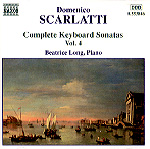With Volume 4, pianist Beatrice Long makes her first appearance in Naxos’ complete Scarlatti sonata survey. Much of her artistry is a joy to behold. The bounce with which she energizes the F minor K. 519 sonata points up the music’s uncanny foreshadowing of Mendelssohn’s elfin scherzos. She makes light of the B major K. 262 sonata’s rapid repeated notes while giving full due to the composer’s astonishing harmonic side comments. Listen to Long dig into the K. 175 sonata’s syncopated left-hand accents and you’ll swear that Scarlatti invented the conga line!
Long is less successful when she fidgets with rhythm. In the E-flat sonata K. 474, for example, she lets the decorative right hand take the lead while relegating the left hand’s steady pulse to the proverbial back burner. It’s interesting to compare Vladimir Horowitz’s firmer, more assertive projection of the left-hand line, which provides a fulcrum that helps the melodic thread to cohere. Long’s rushing of the 16th-notes at the K. 99 sonata’s outset blurs the music’s basic march mood, while conversely she slows down and loses momentum in order to ensure accuracy in the A minor K. 532 sonata’s whirling passagework. On the other hand, she keeps the B-flat sonata K. 550’s surface rock steady, and as a result her agogic adjustments and rubatos become more meaningful and specific.
My main concern lies with noticeable ambient changes within certain tracks: a slightly murkier sonic image from 2:50 on in the opening selection, metallic loud passages in portions of K. 519, but better-balanced dynamics elsewhere. After long, careful listening, I can only conclude that the fault lies not with the pianist but with the editing. In any event, I look forward to Beatrice Long’s further participation in this series.
































